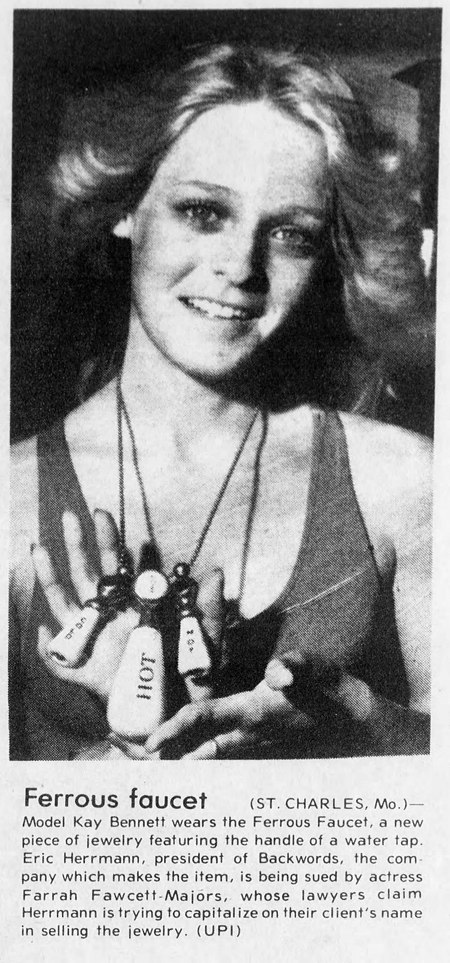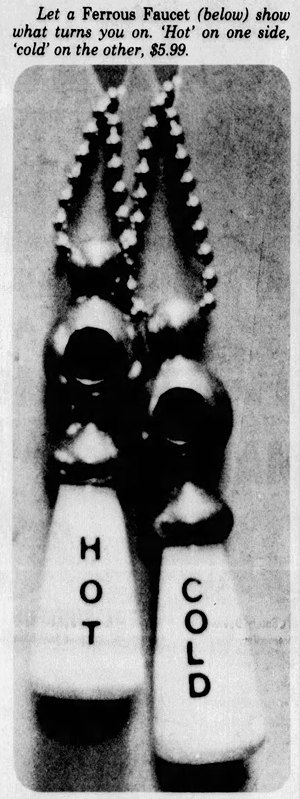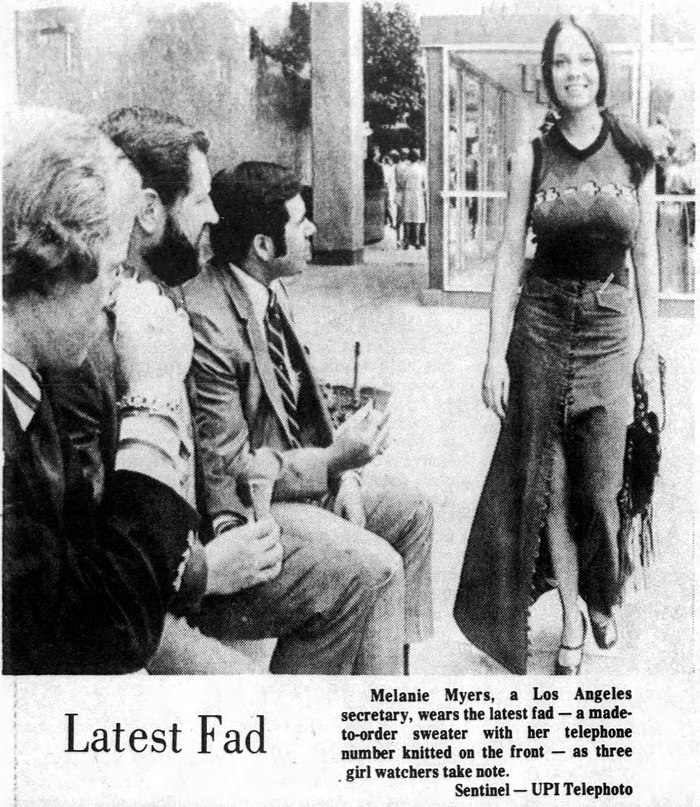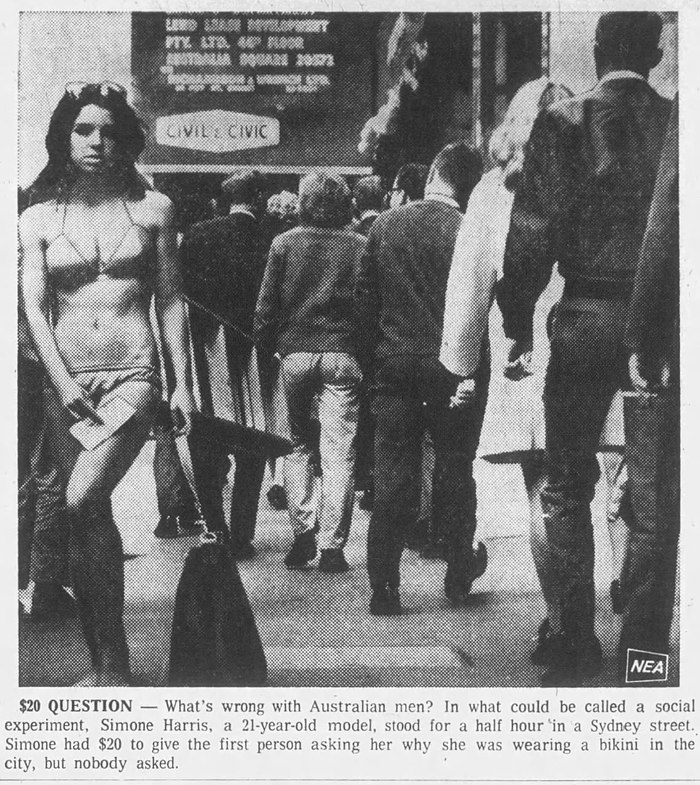1970s
Official fog watchers
I don't know why, but this seems like a very British type of job.
The High Point Enterprise - Feb 6, 1974

image source: onthewight.com
Posted By: Alex - Wed Dec 06, 2017 -
Comments (2)
Category: Jobs and Occupations, 1970s
Where’s Huddles?
Sure, why not transplant THE FLINTSTONES into a contemporary NFL setting? That'll be a hit, for sure!
Wikipedia page.
Posted By: Paul - Mon Dec 04, 2017 -
Comments (3)
Category: Ineptness, Crudity, Talentlessness, Kitsch, and Bad Art, Sports, Television, Cartoons, 1970s
Ferrous Faucets
Back in 1977, a small-time huckster named Eric Herrmann bought a bunch of old, porcelain Hot and Cold faucet handles and got the idea of selling them as necklaces.On the theory that nothing sells like scandal, he called them "Ferrous Faucets," and then asked Farrah Fawcett to endorse them. In response, her lawyers threatened to sue him for capitalizing on their client's name, which apparently was exactly the response he wanted. The controversy was deemed newsworthy, and newspapers throughout the nation ran the photo he supplied them of a model wearing his Ferrous Faucets, thereby boosting his sales.

Shenandoah Evening Herald - July 15, 1977

St. Louis Post-Dispatch - May 25, 1980

image source: worthpoint.com

Tampa Bay Times - Nov 24, 1977
Posted By: Alex - Wed Nov 22, 2017 -
Comments (2)
Category: Jewelry, Publicity Stunts, 1970s
Skiing Mt. Everest
May 6, 1970: Japanese extreme skier Yuichiro Miura became the first person to ski on Mt. Everest. And amazingly, he didn't die. The stunt was filmed and was the subject of a 1975 documentary, The Man Who Skied Down Everest. Check out the clip below.Miura later became the oldest person to reach the summit of Everest, climbing it at the age of 70 and again when he was 80.

Burlington Free Press - May 12, 1970
Posted By: Alex - Tue Nov 21, 2017 -
Comments (3)
Category: Sports, 1970s
Phone Number Sweater
Give every weird pervert in the world your phone number. What could possibly go wrong with that plan?
Carlisle Evening Sentinel - Sep 30, 1971
Posted By: Alex - Mon Nov 20, 2017 -
Comments (6)
Category: Fashion, Telephones, 1970s
Follies of the Madmen #335

Of course! Playing Monopoly drunk! It's the only way!
Original ad here.
Posted By: Paul - Mon Nov 20, 2017 -
Comments (2)
Category: Business, Advertising, Games, 1970s, Alcohol
B. T. Express
Disco, plus train whistles and train sound effects made by mouth: great sounds that go great together?
Wikipedia page on the band.
Posted By: Paul - Sun Nov 19, 2017 -
Comments (0)
Category: Music, Trains and Other Vehicles on Rails, 1970s
Coed Prisons
I hadn't realized that federal and state governments had, for a while, experimented with coed prisons. From Prison Journal, 59(1), Spring/Summer 1979:I'm having difficulty finding out if there still are any coed prisons in the US. I'm guessing there aren't.

Hattiesburg American - Aug 27, 1974
Posted By: Alex - Sat Nov 18, 2017 -
Comments (2)
Category: Prisons, 1970s
Bikini Experiment
So why was Simone Harris standing on a Sydney street in a bikini? Was this a publicity stunt? Was she a psychologist conducting research? A performance artist being weird? I haven't been able to find answers anywhere.
Racine Journal Times - June 17, 1970
Posted By: Alex - Wed Nov 15, 2017 -
Comments (2)
Category: Experiments, Psychology, 1970s
Miss Vacant Lot of the World
The Miss Vacant Lot of the World contest was started in 1972. It was part of the Annual Armadillo Exposition and Confab held in Victoria, Texas. The contest rules were as follows:
Valley Morning Star - May 26, 1975
Here's what I was able to find out about the first six winners of the Miss Vacant Lot title:
1972: Cindy Hudler won for her "dance of the Dasypodidae" which involved waltzing around a vacant lot in an armadillo suit.
1973: Modine Gunch won for standing on her head while spinning a hula-hoop on one leg.
1974: Algeria Sadberry won for playing a song through her nose.
1975: Elvira Rose Hunt (aka Karen Janecka) won for stuffing 264 pennies in her mouth.
1976: Linda Strelczyk won by stuffing 200 poptop tabs into her size 36EEE bikini bra while singing a song titled "Keep Your Finger Out Of It; It Don't Belong To You."
1977: A 200-pound woman (unnamed) won for dressing like an armadillo and singing an armadillo song.
Some of the prizes that the winners received included a trophy, a $25 check, a gift certificate, a bouquet of weeds, and a picture of Secretary of State Henry Kissinger. They also got to wear the Armadillo Crown.
The contest was discontinued in 1979. The organizers noted, "you can only tell the same joke so many times." However, it seems that it was revived at various times, such as in the late 1980s and again in 2011.
Posted By: Alex - Mon Nov 13, 2017 -
Comments (4)
Category: Awards, Prizes, Competitions and Contests, 1970s

| Who We Are |
|---|
| Alex Boese Alex is the creator and curator of the Museum of Hoaxes. He's also the author of various weird, non-fiction, science-themed books such as Elephants on Acid and Psychedelic Apes. Paul Di Filippo Paul has been paid to put weird ideas into fictional form for over thirty years, in his career as a noted science fiction writer. He has recently begun blogging on many curious topics with three fellow writers at The Inferior 4+1. Contact Us |




